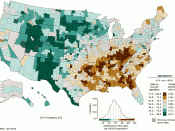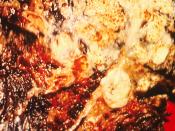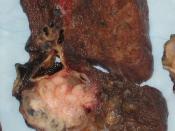For 5/6 of the history of life, all life was unicellular, and went through the cell cycle on a regular basis. As soon as enough growth had occurred, the cell would begin the "S" phase, eventually leading to mitosis and cell division.
Between 600 and 400 million years ago, some eukaryotes became multicellular (animals, plants, fungi). Most of their cells now divide only a limited number of times before pausing in "G1" and specializing. These cells, all formed by mitosis, are genetic clones of the zygote and of all the stem cells that do not specialize. They still have all the genes necessary to move the cell into "S", but these genes are shut off.
Causes
Cancers occur when genes for cell division that should be inactive become activated. This generally occurs when controller genes mutate and stop inhibiting the cell division genes. Typically, several mutations must occur in a single cell before the cell begins to divide out of control.
Sometimes cells with one or more such mutations will look or behave differently from normal specialized cells, or will react differently to chemical tests. This may indicate a higher probability of a cell becoming cancerous in the future. Such cells are called precancerous. Many screening tests look for precancerous cells.
Mutations are errors in the information coded in DNA. While errors can occur at any time if the DNA is damaged, they are much more likely during the "S" phase when the double helix of DNA is "unzipped" for copying. At such times, the cell's proofreading and correction system is less efficient because it cannot compare the damaged strand of DNA to its complementary strand. As a result, cells that divide frequently are much more likely to accumulate mutations and become cancerous. Thus, cancers are most common in tissues...



Excellent
The content and information of this essay are very good. A very good read with excellent information enjoyed reading it..will be in my favourites :)
2 out of 2 people found this comment useful.